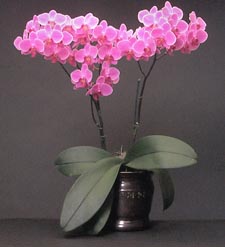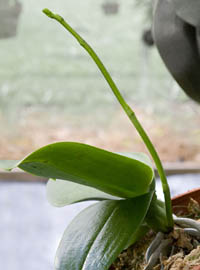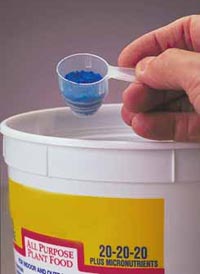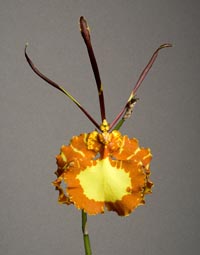|
Welcome to the AOS Beginner�s Newsletter. We will be sending you monthly tips on how to grow orchids and help you get them to bloom again. In addition to the information presented here, we invite you to visit the AOS website at www.aos.org and check out the information found under ORCHID INFORMATION > ORCHID BASICS.

I've Got This Orchid -
now what do I do?
Six easy tips to keep your orchid alive
If you have purchased or were lucky enough to be given an orchid you are about to enter the wonderful world of growing these great plants!
Water
How often you water will depend on the type of orchid and the potting medium. In this issue, we are specifically addressing Phalaenopsis, or Moth Orchids; the most popular orchid for the home. Bark retains less water than moss. If your plant is potted in bark, watering once a week is generally sufficient. If your plant is potted in moss, water when the top feels dry. Another good way is to stick a wood or bamboo skewer down into the pot, being careful to avoid roots. Remove the skewer and if it feels damp, your plant does not need water. After a few waterings you will be able to tell by the weight of the pot whether or not it is time to water again. If in doubt, wait a day. More orchids are killed by overwatering than by neglect!

When you water an orchid you want to let the water run through the plant for a minute or so. Don't use cold water as this will shock the plant. Do not use salt softened or distilled water. Take your orchid to the sink and let tepid water run through the pot to water thoroughly. Be sure to let the plant drain completely. If water remains in the crown of Phalaenopsis plants (where the leaves join in the center), it can provide a perfect environment for fungus or bacteria to do their dirty work. Use a paper towel to blot the water to avoid crown rot.
The amount of light and heat your plant receives will also affect how soon your orchid needs watering. Summer months will need more frequent watering, winter will need less.

Light
Phalaenopsis are 'low' light orchids. They grow beautifully in an east window and can be grown in a south or west window if protected by a sheer curtain. A Phal's leaves should be a medium green. If they are darker it means the plant is not getting enough light; red tinged leaves mean the plant is getting too much light. Once the plant is in bloom you can place it anywhere in your home out of direct sunlight. Other orchids can take more light but it is best to avoid direct sun as this can burn the leaves. Experiment and watch the results. You do not want to burn your orchid but you need to give it enough light so that new flowers will form during its blooming season.
Temperature
Phals are easy to grow because they enjoy the same temperatures we do - above 60°F at night and a range of 70° to 80° or higher during the day. Other orchids can take higher lower temperatures at night. For specifics, consult the AOS Culture Sheets.

Fertilizer
Any balanced orchid fertilizer (look at the numbers on the container, 20-20-20, etc.) can be used to fertilize your orchid. Weakly (half strength), weekly works well. Once a month use clear water to flush any accumulated salts from the potting mix.
Humidity
Use trays of pebbles filled with water to increase humidity around your plants. Be sure the pot does not sit in water as this will rot the roots.
Potting
If a plant is looking poorly and limp and it has not been overwatered (or underwatered, for that matter) it may be that the roots have rotted because the potting mix has become stale and has broken down. Although potting will be addressed in a future newsletter, a word of caution is necessary. Do not repot your orchids in potting soil! Most orchids are epiphytes, air plants, and orchid roots need a potting mix that will allow them to dry out and breathe. Buy orchid potting mix at your local gardening center or big box store. Special mixes are offered for Phalaenopsis and Cattleya - or you can buy a general orchid potting mix. Make sure that the base of the plant sits on top of the mix and is not buried into it.
Orchids are easy to grow. If you follow these basic care requirements your orchid plants will reward you with beautiful blooms - sometimes for months on end, as with Phalaenopsis, one of the easiest orchids to grow in the home!
Greg Allikas
July 2009

Did You Know?
Orchids as a hobby became fashionable in the 1830's. Legend has it that the 6th Duke of Devonshire, William Spencer Cavendish, first encountered an Oncidium (now Psychopsis) papilio at an horticultural exhibition and was captivated by its charm. He became 'hooked' on orchids to the extent that within 10 years he possessed the largest private collection of orchids in existence at that time.
Reinikka, Merle, A History of the Orchid,
Timber Press, Portland Oregon, 1995, p. 26-27
Psychopsis papilio 'Von Scholl' HCC/AOS
| 
